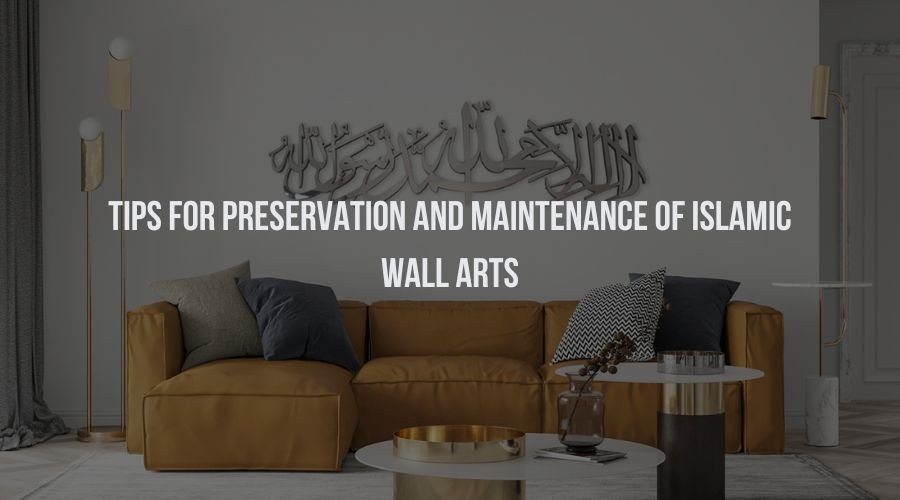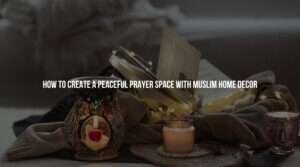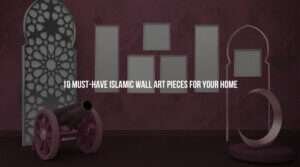Introduction
Islamic art, characterized by its rich geometry, calligraphy, and intricate designs, adorns mosques, mausoleums, and private homes across the globe. Wall art, a prominent element within this tradition, serves not only as decoration but also as a way to convey religious themes and historical narratives. From the mosaic masterpieces of Cordoba to the painted splendors of Topkapi Palace, these artworks hold immense cultural and spiritual significance. At Kiswah Islamic Store, we share your appreciation for this beautiful art form.
While Islamic wall art enriches our lives, time and environmental factors can threaten its longevity. This article equips you with practical tips for preserving and maintaining Islamic art pieces, whether it’s a cherished heirloom or a treasured piece in your home.
Understanding the Artform of Islamic Wall Art
Before diving into specific preservation techniques, it’s crucial to understand the various forms of Islamic decor arts:
Calligraphy
The art of beautiful writing, often featuring verses from the Quran or religious sayings, adorns walls in mosques and other religious structures.
Mosaics
Small, colored tiles meticulously arranged to form intricate geometric patterns or even representational imagery.
Tessellations
A mesmerizing art form where geometric shapes interlock seamlessly, creating mesmerizing patterns.
Muraqqa (album paintings)
Hand-painted or illuminated manuscripts bound together, often featuring floral motifs, calligraphy, or miniature paintings.
Stuccowork
Decorative plaster used to create raised or molded designs on walls and ceilings.
Preventive Measures for Islamic Wall Art
The old adage, “prevention is better than cure,” holds true for Islamic wall art. Here are some proactive steps you can take:
Climate Control
Maintaining a stable temperature and humidity level is crucial. Excessive heat and humidity can cause pigments to fade, plaster to crack, and organic materials to deteriorate. Invest in air conditioning and dehumidifiers if necessary.
Lighting
Direct sunlight can damage pigments and cause fading. Consider using UV filters on windows or installing indirect lighting.
Air Quality
Control dust and air pollution, which can cause grime buildup and degrade the artwork. Regularly clean air filters and maintain a clean environment.
Disaster Preparedness
Have a plan in place for fire, flood, or earthquake emergencies. This might involve securing loose elements, having a designated storage area for evacuated artwork, and ensuring proper insurance coverage.
Gentle Cleaning Techniques for Islamic Wall Art
Sometimes, despite our best efforts, cleaning becomes necessary. Here’s how to approach it cautiously:
Start Soft
Always begin with the least invasive method possible. For dust, use a soft brush with natural bristles. For light grime, a damp cloth with clean, distilled water might suffice.
Know Your Materials
Never use harsh chemicals or abrasive cleaners. Research the specific materials used in the artwork and consult a professional conservator for guidance on appropriate cleaning solutions.
Professional Help
For extensive cleaning or restoration projects, don’t hesitate to seek the expertise of a qualified conservator. They possess the knowledge, skills, and specialized tools to handle delicate artwork safely and effectively.
Additional Care Considerations for Islamic Wall Art
Here are some everyday practices that contribute significantly to the preservation of Islamic decor arts:
Minimize Touch
Oil from our hands can damage the artwork. Encourage visitors to maintain a distance and avoid touching the art directly.
Mind the Furniture
Avoid placing furniture too close to the walls, as bumping or leaning can cause damage.
Document Everything
Maintain detailed records of the artwork’s condition, including photographs and any conservation interventions undertaken. This will be invaluable for future reference.
Building a Culture of Preservation for Islamic Wall Art
Preserving Islamic wall art is a collective responsibility. Here are some ways to create a culture of care:
Raise Awareness
Educate the public about the importance of Islamic art and the threats it faces. Organize workshops or talks on preservation techniques.
Support Conservation Efforts
Donate to organizations working on the preservation of Islamic art or sponsor restoration projects.
Advocate for Policies
Support policies that promote the protection of cultural heritage sites and encourage the use of appropriate conservation practices.
Conclusion
By following these tips and fostering a culture of preservation, we can ensure that the splendor and spiritual significance of Islamic wall art continue to inspire future generations.
At Kiswah Islamic Store, we are passionate about Islamic art and culture. We offer a beautiful selection of Islamic decor pieces that reflects the richness and tradition of this art form. We hope this article empowers you to care for your own Muslim home decor collection and helps us all preserve this cultural treasure for generations to come.




